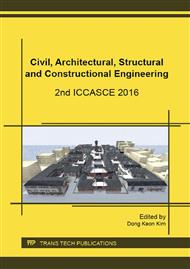p.319
p.325
p.335
p.342
p.348
p.354
p.359
p.366
p.371
Effects of Incubation Temperature, Repeated Application, and Heavy Metal Addition on Degradation of Nitrification Inhibitor 3,4-Dimethylpyrazole Phosphate (DMPP) in Burozem with Model Experiments
Abstract:
3,4-Dimethylpyrazole phosphate (DMPP) is used to inhibit nitrification when NH4+ or NH4+-producing fertilizers are applied in agricultural and horticultural systems. The kinetics of DMPP decomposition were studied in pretreated and non-pretreated burozems, using model experiments. DMPP was added in same concentration (50 mg·kg-1) but incubated at various temperatures (15, 23 and 30°C). Additionally, DMPP degradation was examined after treatment with Cu2+ or Cd2+ at various doses. When DMPP was applied into the non-pretreated soil, a delay phase of about 9.5-27.4 days appeared in the initial stage of degradation. However, the delay phase disappeared when DMPP was applied into the pretreated soil. The half-life of DMPP in the non-pretreated soil was higher than that of the pretreated soil by about 58-86%. These indicated that an inducible metabolic degradation occurred, following first-order kinetics. The mineralization rate of DMPP was enhanced by increasing temperature, and the half-life decreased significantly with increasing temperature, both in pretreated and non-pretreated soil. With the addition of DMPP and heavy metal (Cu2+ or Cd2+) in the soil, the content of DMPP was different from CK after incubation, and the mineralization of DMPP was significantly decreased with the increase of heavy metal addition. The lower additional amount of Cu2+ (20 mg·kg-1) or Cd2+ (1 mg·kg-1) promoted the degradation of DMPP, while higher additional amount of Cu2+ (500 mg·kg-1) or Cd2+ (25 mg·kg-1) significantly inhibited the decomposition of DMPP.
Info:
Periodical:
Pages:
348-353
Citation:
Online since:
November 2016
Authors:
Price:
Сopyright:
© 2017 Trans Tech Publications Ltd. All Rights Reserved
Share:
Citation:


